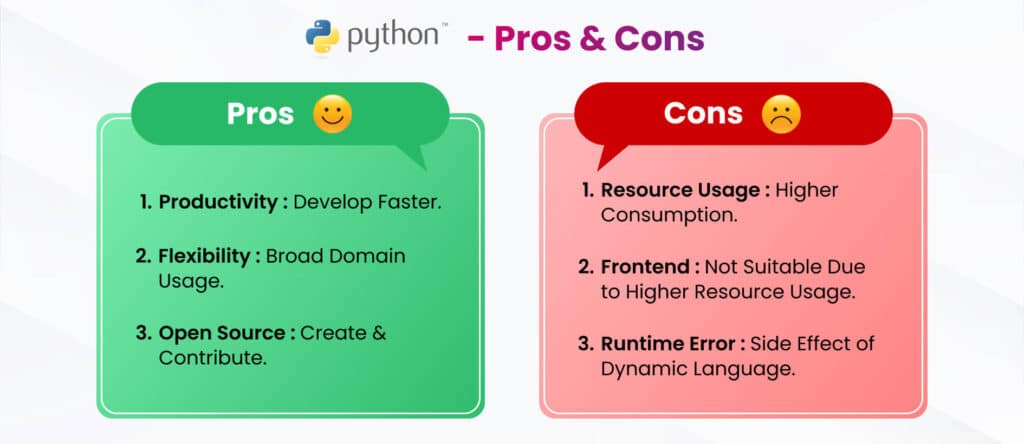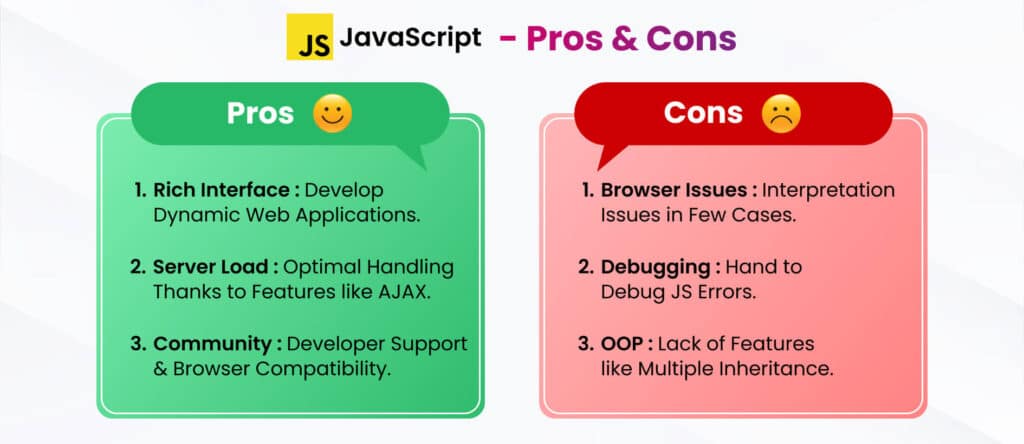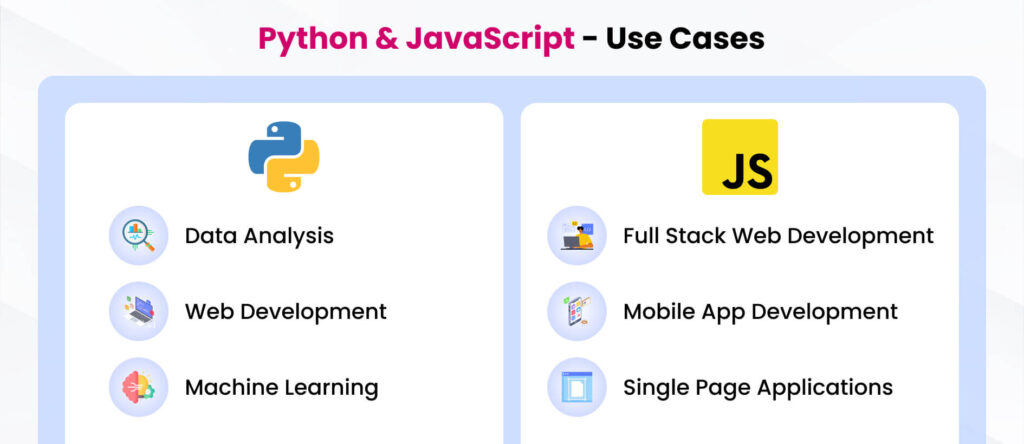Introduction
In modern times, there are many different programming languages that you can use, but Python and JavaScript remain the two most popular ones. Whether you aspire to enter the coding world, or if you want to deepen your knowledge of coding languages, learning Python vs JavaScript is going to be an invaluable experience for you to build a long and fast-growing career in the tech industry. Though both languages are popular among developers and powerful, they differ significantly in many ways. Interested in knowing the differences? Let us get started with this blog post!
A Brief Overview of Python and JavaScript
Python programming is a general-purpose, high-level programming language released in 1991. It’s known for its simplicity and readability, making it an ideal language for beginners. Python language supports multiple programming paradigms, including object-oriented, functional, and procedural. Its syntax is easy to read and write, focusing on code readability. Python is widely used in scientific computing, data analysis, web development, artificial intelligence, and machine learning.
JavaScript is a programming language that was primarily created for the web development. It is versatile and flexible, allowing developers to create dynamic and interactive web pages, mobile and server-side applications. JavaScript is often used with HTML and CSS to create rich front end / UI of the web applications. Over the years, JavaScript has been enriched with many libraries and frameworks, making it popular for both front-end and back-end development.
Python and JavaScript - Pros and Cons
Every programming language has its own pros and cons. Depending on the purpose, the appropriate programming language needs to be chosen. In our case, let us understand the pros and cons of both Pythona and JavaScript.
Python - Pros
Productivity: One of the most crucial advantages of Python programming is its high productivity. Due to the simplicity of the language, developers can focus more on solving problems. They do not need to spend their valuable time on syntax and behaviour. Thus, Python can easily solve complex issues with less time and effort.
Flexibility: The advantage of Python language over other languages is that it offers you high flexibility so you can try new things thanks to its rich library support. You can create many different types of Artificial Intelligence, Machine Learning, and Data Analytics related applications using Python. It does not restrict you in anyway from trying new things.
Open-source: Python has an OSI-approved open-source license. This means it is free to use and distribute. With Python, you can download core source code and develop additional frameworks, libraries, and tools you may want. This can be made re-usable and help in development.

Python - Cons
Inefficient Memory: Python consumes memory because it is a dynamically typed language and doesn’t give much importance to optimised memory usage. It offers simplicity to programmers and consumes a very high amount of memory. Thus, Python programming is not suitable for applications for which you are looking for better memory optimization, like in the case of Embedded Systems.
Front End Applications: Python is generally a server-side programming language, and we do not see Python used much on client-side web applications or in mobile applications. As mentioned above, Python has high memory consumption, resulting in slower load time. In case of front-end applications having relatively lesser computing resources, it makes it difficult to run Python.
Runtime Errors: Python language is dynamic and allows you to change a variable’s data type at any time. A python language variable that holds an integer value may hold a string value in the future. This causes runtime errors for Python. Thus, developers need to do testing several times.
JavaScript - Pros
Rich Interface: JavaScript provides multiple functional and maker interfaces to programmers for creating engaging web pages. It has got many features like forms, animation support, event handling, DOM / BOM handling which helps developers to create a engaging front-end / UI.
Server Load: JavaScript majorly runs on the client-side is capable of performing functionalities data validation. Such functionality can reduce load on the server as the data doesn’t need to be sent all the way to the server. Features like Asynchronous Javascript And XML (AJAX) can significantly reduce the load on the server as there is no need to load the whole website, rather only a section needs to be updated (Ex: Stock market prices, Cricket scores, Weather updates, etc..)
Large community and popularity: All browsers and other languages support Python vs JavaScript as it has become the only accepted language across all the browsers. With the advent of JavaScript getting used on the server side, the community support has grown leaps and bounds. It continues to be one of the most popular programming languages among developers used from reputed companies like Amazon, PayPal, Google, Etc.

JavaScript - Cons
Browser Support: Though server-side scripts produce different outputs, sometimes different browsers interpret JavaScript code in different ways. Though these differences are minimal nowadays, you need to test your code in all other browsers.
Debugging Facilities: Some HTML editors support debugging of JavaScript code, but they are not as efficient as C/C++ or Python editors. In contrast, browsers do not show errors, making it difficult for JavaScript developers to debug them.
Single inheritance: JavaScript supports only single inheritance. The functionality of multiple inheritance is not supported in JavaScript. For developers who are used to full blown Object Oriented Programming languages like Python, JavaScript’s limitations comes our as a constraint in terms of developing re-usable applications.
Use Cases of Python and JavaScript
Now that you understand the pros and cons of both languages, let us see what type of domains or projects these languages can be appropriately used for.

Python Use Cases
Data Analysis: Python’s powerful libraries for data analysis, such as NumPy and Pandas, make it a popular choice for data scientists and analysts. NumPy is an example of a package that has many core functions valuable to data analysis such as min, max, mean, standard deviation, and anything else you would expect in a program like Excel. In addition to using NumPy to perform array arithmetic (mathematical operations down a column of data basically), you can also learn about lambda expressions, a super useful operation that comes out of the box in Python.
Web development: Python’s ease of use and flexibility make it a good choice for web development, especially for building scalable and maintainable back-end services with frameworks like Django or Flask. For Example, Python is scalable for web applications, so it can handle lots of traffic and information (in the form of photos being sent and received in this case), making it perfect for Instagram’s needs. Instagram also uses Python to suggest content you’ll like, just as Amazon does.
Machine learning: Python’s extensive support for machine learning libraries, such as TensorFlow, Pytorch and Scikit-learn, makes it a popular choice for developing machine learning models and applications. For Example, Amazon is heavily driven by machine learning in many features (ex: the recommendation engine in the Amazon e-commerce portal). Python is the dominant language for creating such machine learning models.
JavaScript Use Cases
Front-end web development: JavaScript is the only language that can be executed in a web browser, making it essential for front-end web development. Popular front-end frameworks like React, Angular and Vue are built using JavaScript. Using these frameworks, users can develop rich front-end applications, which are also known as Single Page Applications or SPA.
Back-end web development: As mentioned above, JavaScript started off as a Front-end development language and later made forays into the back-end development as well. Thanks to the invention of Node.js a JavaScript run-time environment, in combination with Express.js, the JavaScript has emerged as a powerful backend programming language as well. The developer can learn one language and use it in both Front-end and Back-end, thereby enabling the JavaScript Everywhere phenomenon.
Mobile app development: JavaScript can be used with frameworks like React Native or Ionic to develop cross-platform mobile applications. Once the application is developed using say React native, the application can be eventually built for multiple mobile platforms like Android, Android TV, iOS and tvOS by enabling developers to use the React framework along with native platform capabilities.
Python or JavaScript, which is better for the future?
As called out above, every programming language has its own pros and cons. It depends on your project requirement and choose the right one.
JavaScript was initially created for speed on the web, making it faster than Python in some scenarios. For example, JavaScript’s Node.js offers advanced multithreading capabilities, while Python processes requests in a single thread. As a result, JavaScript is often preferred for applications requiring real-time and dynamic interactions, such as websites, ERP apps, and platforms like Facebook that need to handle vast amounts of real-time data without causing delays for users.
Python, on the other hand, excels in CPU-intensive tasks, such as machine learning models that require processing large datasets to solve complex problems. Its straightforward syntax makes it a popular choice for developing large-scale applications, especially those that are math-intensive. Although Instagram’s server environment, which is more I/O-intensive than CPU-intensive, uses Python, it demonstrates Python’s capability to perform efficiently when properly optimized.
When deciding between Python vs JavaScript, consider their strengths, weaknesses, project requirements, and team expertise. Python offers versatility, extensive libraries, and strong support for different programming paradigms, which makes it an excellent choice for long-term projects across various domains, particularly in data science. Meanwhile, JavaScript remains the dominant language for web development due to its asynchronous, event-driven nature, ensuring its continued relevance in client-side programming.
Conclusion
Python and JavaScript are powerful programming languages with distinct advantages and applications. Ultimately, you should select which one to learn depending on your interests, career goals, and projects you wish to undertake. No matter which language you decide to learn, proficiency in Python vs JavaScript will undoubtedly advance your skills as a programmer and open exciting career prospects in today’s fast-moving technology sector.
| Serial No. | Related Blogs | Links |
|---|---|---|
| 1. | Python Programming | Course Home | Click Here |
| 2. | Android System Development Course | Click Here |
People Also Ask (PAA)
When choosing between Python and JavaScript for web development, developers should consider factors such as the project requirements, the need for backend or frontend development, and the programming paradigms and features best suited for the project.
Yes, JavaScript frameworks such as Node.js, Express.js, and React can be used to achieve functionalities similar to Python’s web development frameworks. These JavaScript frameworks provide tools and libraries for server-side and client-side development, enabling web applications to be built with JavaScript.
Yes, Python can be used for web development. It offers various frameworks such as Django and Flask, which enable developers to create web applications using Python.
